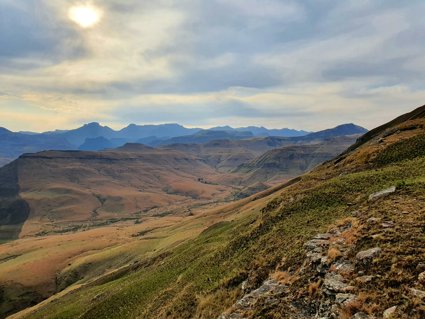
Lesson three: Practical task
Key questions
How do researchers collect samples of cold climate landforms?
How are samples analysed in the laboratory to determine the landform’s origin?
How can the age of the landforms be determined?
How can the climate reconstructions based on them be compared with other types of past climate records?
Aims
To learn about some field and laboratory methods, to interpret a set of surface exposure dates, and to compare these with evidence from Indian Ocean marine sediments.
This lesson supports teaching of field techniques in cold environments and provides a skills exercise on descriptive statistics using surface exposure dates.
Starter
Ask the researcher
Use the Q and A sheet to get an answer about how and why certain field methods and laboratory analyses are carried out. Download the grid where you can note down key points.
-
Why is it necessary to map landforms in the field when we have aerial photography and satellite imagery? (see Lesson two)
-
How do you map landforms in the field?
-
How much can you tell about a landform in the field before analysing any samples in the lab?
-
Why do you need to bring samples back from the field, and how do you collect samples of landforms?
-
What kinds of laboratory analyses are used to determine if a landform has a glacial origin or not?
-
What methods can be used to work out the age of a glacial landform?
-
Why are you using the surface exposure dating method and how does it work?
-
What do you look for, and how do you sample landforms for surface exposure dating?
-
You can also view a video clip of sampling for surface exposure dating.
Main Activity
In this part of the lesson, you will look at a set of surface exposure dates illustrating what might be found in the Drakensberg and draw conclusions about the age of the sampled landform. Remember that the presence of glacial and periglacial landforms enables reconstruction of past climate conditions; and, once an age range for a landform is obtained, the climate inferences based on it can be compared with other records of change to better understand the Earth’s climate.
Geological time lines
Before looking at the surface exposure dates, it is useful to be aware of how geological time is divided up and to be familiar with the global patterns of climate change that have occurred over different timescales. Complete the worksheet with the help of the hyperlinks to websites contained within it.
Descriptive statistics exercise with surface exposure dates
Open the spreadsheet to view a sample data set of eleven surface exposure dates on a moraine.
Answer the following questions (either by hand or in Excel):
-
From column A, work out the average date of the 11 age estimates (the mean) and work out the median date. (Remember that the median is simply the middle value)
-
Taking into account all the dates, which of these two ‘measures of central tendency’ do you think is likely to be the better approximation of the true age of this moraine and why?
-
Why do you think each surface exposure date includes its own error range (standard deviation)?
-
This time taking account of all the standard deviations, work out the full age range likely for the moraine according to this data set
-
Looking at the distribution of the dates, what do you think would be a best estimate of the age range of the moraine and why? (Hint: you might disregard any apparent anomalies, and double the ‘average standard deviation’ around your chosen mean or median value so you have 95% confidence of the time span during which the moraine was formed)
-
Did the formation of this moraine occur during the LGM? And how confident can you be?
Plenary
View a sea surface temperature (SST) reconstruction based on a marine sediment core from off the coast of southern Africa, as well as two other slides showing present and LGM Indian Ocean SSTs.
Using your interpretation of the surface exposure dates from the second main activity, answer the following questions:
-
How does your cold climate evidence (formation of a moraine) from the High Drakensberg relate to the SST reconstruction shown in Slide one
Looking at Slide one, give an estimate of the SST at the time of formation of the moraine.
How much colder is this than the present SST in this graph?
Looking at Slides two and three, describe the differences you can identify between the Indian Ocean SSTs today and the SSTs during the LGM.
In small groups discuss the following ideas:
-
Why might you expect a correlation between colder seas off the coast of southern Africa and a colder mean annual temperature in the Drakensberg?
-
In what ways do you think oceans affect the climate experienced over land? (Think of both temperature and precipitation)
During the LGM, the zones of mid-latitude westerly winds in both hemispheres occurred at lower latitudes than today. This was related to the fact that the ‘polar front’ (boundary between warmer and colder waters in the oceans) was also located at lower latitudes during the LGM.
-
Can you guess why this difference in winds, and ocean temperature off the coast, might have caused the Drakensberg during the LGM to experience relatively more winter precipitation, and less summer precipitation, than occurs today?
-
Can you summarise why researching past glaciation in the High Drakensberg provides an important test of what we think the climate in South Africa was like during the LGM?
The following links provide more information about how changes in the oceans affect climate over different timescales.
To learn more about the Quaternary Period in general visit:
To learn more about causes for climate change on different timescales visit:
